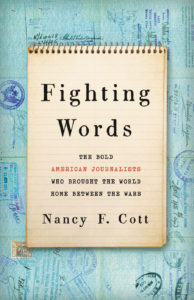The Provincetown INDEPENDENT
April 2020
Book Review:
Fighting Words, Four Reporters Who Shook the World
![]() See the original on-line article
See the original on-line article
It is generally accepted that what news reporters write is consigned to obscurity. Journalism from long ago may be useful for documenting a certain time or place, but, otherwise, the “first draft of history,” by design, is not particularly interesting for its style or opinions. Historian Nancy F. Cott challenges such assessments with verve in her fascinating book, Fighting Words: The Bold American Journalists Who Brought the World Home Between the Wars.

Cott examines the work and lives of four Americans whose international reporting appeared in print from about 1920 to 1945: James Vincent Sheean, John Gunther, Rayna Raphaelson, and Dorothy Thompson. “Journalists,” Cott explains, “were among the most peripatetic of the younger generation who, by exploring foreign perspectives, countered insular policies and provincial attitudes in the United States.”
These four were exceptionally talented, Cott explains, and they were also entirely representative of their generation. Young people in the interwar years, her research demonstrates, traveled abroad at a time when it was easy and relatively inexpensive to venture beyond U.S. soil.
The reporters Cott has chosen as her subjects were well known while they were writing, but they now likely won’t register on readers’ radar. Raphaelson’s record is the thinnest. Her compelling career ended abruptly in Stalin’s Moscow when an illness cut her life short. Later in their careers, Sheean and Gunther wrote best-selling books reflecting on their reporting. Thompson, meanwhile, distinguished herself as one of the few women who expressed an anti-fascist stance on a world stage. Historians have focused on Thompson because of her marriage to Nobel Prize-winning novelist Sinclair Lewis, her political columns, and her trenchant wit.
Cott dexterously chronicles the ways these four, who were friends, traversed the globe to explain seismic shifts in politics and peoplehood. Fighting Words includes explanations of the conflict in “the Rif” in Morocco, the Bolshevik Revolution, the coalescence of the Chinese Communist Party, the beginnings of the state of Israel, the emergence of fascism in Europe, and the rise of Hitler and the Nazi Party in Germany. Maps help readers appreciate relationships and space.
There’s a tension in the book that somewhat undermines Cott’s claims about these reporters’ exceptionalism. In a book titled Fighting Words, there should be plenty of these writers’ words. But most of what Cott reveals to readers comes from the reporters’ diaries and letters rather than their actual articles. Cott shifts her strategy in the last third of the book, when she shows her characters publishing reflections, first-person accounts, and opinion pieces. For example, she details Thompson’s extraordinary rise as a woman in the 1930s to become one of America’s foremost political commentators, describing her pieces but rarely quoting from them: “Amid tough competition, Thompson soared like a helium balloon over others filled only with air.” It’s exciting to get a sense of that balloon when Cott finally begins incorporating quotes from Thompson’s writing in the ’30s. Of Germany, for example, Thompson opined in 1934: “Other dictators have murdered democracy. Hitler persuaded it to commit suicide.”Fighting Words also weaves together facts about the emergence of a modern press. Ever wonder where the big news syndicates such as U.P.I. came from? How the telegraph changed the pace of news writing? Cott explains how foreign correspondents cultivated contacts and gained credentials, and how they managed to travel from place to place. In addition, she includes information having to do with the rise of the modern newspaper and expectations of objectivity and ethics.
Cott’s decision to focus on these writers’ sex lives can, at times, feel prurient. Diaries and letters provide details of one-night stands, affairs, cruising, divorces, abortions, and sexual fluidity. As a noted historian of American feminism and of marriage, Cott justifies their inclusion as a way to explain what was different about this generation, which, she writes, represented the ways young people between the wars were “rethinking relationships between women and men, as much as between themselves and the world, as much as between peoples and political systems.” Cott argues that these pointed “to an alternative future,” though it evaporated during and after World War II, as advertising, films, and political movements imposed rigid divisions between masculinity and femininity and advanced expectations of heterosexual marriage for life.
Fighting Words could not appear at a better time. Cott’s reporters were “writing about distant political urgencies” and “alerted fellow Americans to tie their own fates to that of the rest of the world.” Older teens curious about geography and about sex, those belonging to book clubs, and anyone wanting a refresher on global history will enjoy Cott’s approachable book. All will appreciate time spent with these mostly forgotten writers, especially Thompson, whose words might serve as an inspiration in the pandemic: “Every individual bears a responsibility for the whole of mankind,” Thompson wrote. “Human civilization is based on the recognition of that responsibility. The moment anyone denies this responsibility, he makes himself an accomplice of humanity’s crimes. The moral crisis of our times has arisen from the denial of this responsibility.”